|
|
|
 |
| |
In the ninth installment in the series looking at
the world of James Bond, we visit Germany...
|
|
The World Of James Bond - Germany
8th February 2005
Munic
After the ordeal in Switzerland
in On Her Majesty’s Secret Service, James Bond
arrives in Munich from Zurich. Counting down the days to his wedding,
he is met at the airport by Tracy, who drives him to her “favourite
hotel in the world”, the Vier Jahreszeiten. The Vier Jahreszeiten
(Maximilianstrasse 17) is Germany’s most famous hotel and
supposed to be one of the finest hotels in the world. Since opening
in 1858, it has been home from home to many VIPs, Royalty and
heads of state and its rooms and suites combine the charm of days
gone by with modern luxuries.
| Once in the hotel, Tracy changes the dressings
on Bond’s wounds and then chatters excitedly about
their forthcoming wedding. However, Bond has something else
on his mind. “‘Drinks,’ said Bond firmly.
‘We’ve got all the time in the world to talk
about love.’ - ‘You are a pig,’ she said
indignantly.”
Following the hotel bar, Bond’s plan is to dine at
Walterspiel’s “to talk about rings… and
other exciting things to do with being married”. You
can no longer find Walterspiel’s, but it had an excellent
reputation and was located in the hotel. |
|
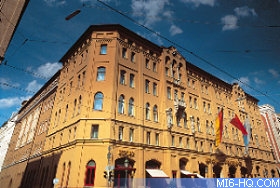
Above: The Vier Jahreszeiten in Munich |
And so James Bond gets to work “searching the antique shops
for an engagement and a wedding ring. The latter was easy, the traditional
plain gold band, but Tracy couldn’t make up her mind about
the engagement ring and finally dispatched Bond to find something
he liked”. Hiring a taxi driven by en ex-Luftwaffe pilot,
“Bond found what he wanted – a baroque ring in white
gold with two diamond hands clasped. It was graceful and simple
and the taxi-man was also in favour, so the deal was done and the
two men went off to celebrate at the Franziskaner Keller, where
they ate mounds of Weisswurst and drank four steins of beer each”.
Franziskaner Keller (Hochstrasse 7) is supposedly the oldest restaurant
in Munich and known for serving tradition German fare. Returning
to the hotel, Tracy loves the ring, but exclaims ‘Oh, James,
you are so bad. You stink like a pig of beer and sausages. Where
have you been?’
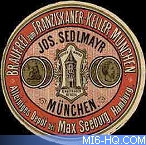 |
|
The following morning, “a crystal-clear
New Year’s Day”, James Bond and Tracy were married
“in the British Consul General’s drawing room”.
After a short ceremony they head towards Kitzbühel
in Austria in Tracy’s Lancia.
Taking a relaxed pace to enjoy the route, they are joined
on the road by a red Maserati, which then starts to overtake
them. Suddenly the “windscreen of the Lancia disappeared
as if hit by a monster fist. Bond caught a glimpse of a
taut, snarling mouth under a syphilitic nose, the flash-eliminator
of some automatic gun being withdrawn, and then the red
car was past and the Lancia was going like hell off the
verge across a stretch of snow and smashing a path through
a young copse.”
|
The next thing Bond knows is when he is shaken into consciousness
by a member of the Autobahn Patrol, whose “young face was
stark with horror.”
“Bond turned towards Tracy. She was lying forward with
her face buried in the ruins of the steering-wheel. Her pink handkerchief
had come off and the bell of golden hair hung down and hid her
face. Bond put his arm around her shoulders, across which the
dark patches had begun to flower… ‘It’s quite
all right. She’s having a rest. We’ll be going on
soon. There’s no hurry. You see –‘ Bond’s
head sank down against hers and he whispered into her hair –
‘you see, we’ve got all the time in the world.’”
| Berlin
In the short story The Living Daylights, James
Bond is sent to West Berlin to foil the assassination of
a double agent who is crossing from the east, by shooting
a Russian sniper known only as “Trigger”.
Arriving in Berlin, we immediately get an idea of the city
at the height of the cold war: “The ugly six-storey
building at the corner of Kochstrasse and the Wilhelmstrasse
was the only one standing in a waste of empty bombed space.
Bond paid off his taxi and got a brief impression of waist-high
weeds and half-tidied rubble walls stretching away to a
big deserted crossroads lit by a central cluster of yellowish
arc lamps”.
|
|
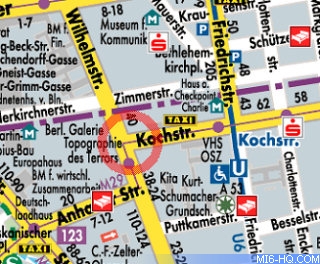
Above: The location of the ugly six-storey
building. Note the location of Checkpoint Charlie and the
Berlin Wall (dashed line parallel to Zimmerstrasse |
The story is set in 1960, a year before construction of the Berlin
Wall was started to prevent the flow of refugees to the west and
when American and Russian tanks stood face-to-face at Checkpoint
Charlie.
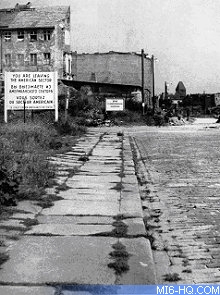
Above: 1960s West Berlin |
|
Bond is not happy with his assignment and
“had always found Berlin a glum, inimical city varnished
on the Western side with a brittle veneer of gimcrack polish,
rather like the chromium trim on American motor-cars”.
This last comment is intended to be tongue-in-cheek, as
Ian Fleming owned American cars from 1955 onwards –
his first Ford Thunderbird was bought with the proceeds
from the sale of the film rights to Casino Royale for £6,000.
Being a short story, and due to the fact that the action
takes place in and around that ugly six-storey building,
we don’t get to see much of Berlin.
We have the details of his first day when Bond “walked
to the Kurftürstendamm, sat in the Café Marquardt,
drank an espresso and moodily watched the obedient queues
of pedestrians waiting for the ‘Go’ sign on
the traffic lights”. |
| Bond is killing time during the day, as
the double agent will make his attempt at crossing on one
of three nights, between six and seven in the evening and
while sitting in the café tries to decide what to
do with his afternoon.
“It finally came down to a choice between that respectable-looking
brownstone house in the Clausewitzstrasse, known to all
concierges and taxi-drivers, or a trip to the Wannsee and
a strenuous walk in the Grunewald. Virtue triumphed”. |
|
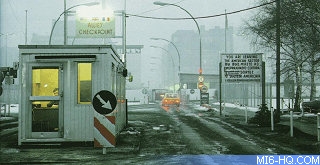
Above: Checkpoint Charlie |
After walking for two hours he finds a restaurant by the lake. To
prove that he is not too virtuous, Bond orders “a double portion
of matjes herrings smothered in cream and onion rings, and two ‘Molle
mit Korn’, the Berlin equivalent of a ‘boiler-maker
and his assistant’ – schnapps, doubles, washed down
with draught Löwenbräu”.
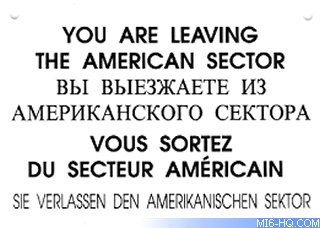
Above: The famous sign displayed at
Checkpoint Charlie. |
|
That evening, waiting for the appearance
of the defecting agent, Bond watches a woman’s orchestra
enter the building where he expects the soviet sniper to
be (it is the building for the Ministry of Culture, after
all).
Watching through his Sniperscope he sees a girl carrying
a cello case: “The girl was taller than the others
and her long, straight, fair hair, falling to her shoulders,
shone like molten gold under the arcs at the intersection”
and after she disappears from his sight he realises that
he has become obsessed by her. Still behind his rifle and
Sniperscope, Bond can’t get her out of his head. |
| Wondering why she had chosen the cello
he decides that there “was something almost indecent
in the idea of that bulbous, ungainly instrument between
her splayed thighs. Of course Suggia had managed to look
elegant, and so did that girl Amaryllis somebody. But they
should invent a way for women to play the damned thing side-saddle”.
Once again this story demonstrates the lighthearted side
to Fleming, “that girl Amaryllis somebody” was
Amaryllis Fleming, his half sister fathered by the artist
Augustus John.
The agent fails to appear that evening and we are told
that the “next day, and the next night-watch, were
duplicates, with small variations, of the first”,
so that “James Bond crammed the third day with an
almost lunatic programme of museums, art galleries, the
zoo and a film, hardly perceiving anything he looked at”.
Of course, the final evening sees the appearance of the
defecting agent and James Bond finally gets his chance to
do the job and leave that glum city.
|
|
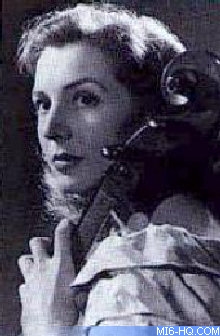
Above: Amaryllis, half sister of Ian
Fleming |
"The World Of James Bond" will visit Japan next
month...
Article by David Leigh.
|
|
|